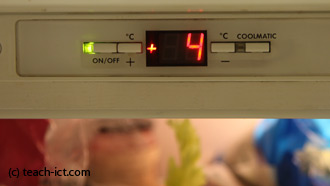3. Sensors
A sensor is a device designed to measure some physical quantity in its environment. An example might be a heat sensor that measures the temperature in a room or a pressure sensitive mat that detects someone walking over it.
 |
|---|
| A temperature sensor is tucked away somewhere inside this fridge and its output is used by the display you see. The output could as easily be fed into a computer for further processing. |
Once they have taken a reading or measurement, they might send that reading straight back to the computer or they may store it up and take a set of readings over time and send them back in a batch.
This data is called an ‘input’. Whilst the sensor itself is producing an 'output'.
There are many different types of sensors, below is a table showing you a few of the most common ones:
| Sensor | Measures | Where Used |
|---|---|---|
| Heat | Temperature | Living room for central heating system |
| Humidity | Water vapour in the air | Swimming pool, greenhouse |
| Infra-red | Infra-red radiation e.g. body heat | Security alarm systems |
| Light | Light levels | External security lights |
| PH | Acid/alkali levels e.g. pH of soil | Environmental experiments, river pollution |
| Pressure | Pressure | Burglar alarm systems, automatic doors |
| Smoke | Smoke in the atmosphere | Offices |
| Sound | Levels of sound | Security alarm systems |
| Tilt | Angle of tilt | Windows in security alarm system |
| Touch | Detects if one object bumps into another | Computer controlled robots |
Challenge see if you can find out one extra fact on this topic that we haven't already told you
Click on this link: Sensors
